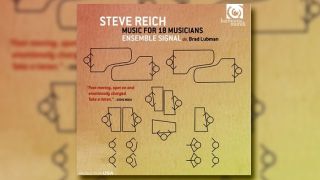Along with Terry Riley and Philip Glass, Steve Reich stands as one of minimalism’s best known composers, and it’s the reverberations of this album that took him way beyond the relatively secluded contemporary classical/avant-garde enclave.
While some of the most famous examples of the minimalist canon can sometimes appear didactic, cerebral exercises more concerned with process than any potential emotional connection, this mesmeric 60-minute piece composed by Reich between 1974 and 1976 radiates warmth, intimacy and actual melodies you can sing and hum along to. This last point might also have a bearing on the fact that album sold 10,000 copies in its first year and remains his most famous and enduring work.
Ashley Capps, in his essay accompanying the stunning and highly recommended 2015 recording by Ensemble Signal (Harmonia Mundi), highlights the piece’s wider appeal: “While it was in no way rock, it had a rock and roll heart.” No surprise then that echoes of that beating heart reverberated through Bowie’s Low, King Crimson’s Discipline, and countless others in fields as diverse as math rock, post-rock and electronica.
Scored for violin, cello, two clarinets, four female voices, three marimbas, two xylophones, metallophone and four pianos, the piece consists of just 11 chords whose regular pulsing and transitions create seamlessly interlocking melodies that ricochet off one another thereby fashioning new rhythms and micro-themes. They produce a complex but ultimately joyous bustle whose vibrant overtones generate an audio illusion that gives the impression of a work that’s far more symphonic in scope and detail.
A critical triumph at its world premier in 1976 by Reich’s own performing ensemble and now recognised as a masterpiece, it was the culmination of an artistic journey that had seen the composer move away from the austere monochrome of his 1960s experimentation with tape loops with which he’d established himself. While the rigorous polyrhythms of Drumming, Six Pianos and Music For Mallet Instruments, Voices And Organ replicated the phasing effect that had so beguiled him through his use of magnetic tape, they were the testing ground for far richer harmonic ingredients that would reach a dazzling and dramatic fruition in Music For 18 Musicians.
Written and developed in the lofts of New York, it’s entirely natural that it pulsates with the buzzing momentum of a city forever in motion. Charged with rising, restless waves of karmic interconnectedness, Reich nevertheless manages to anchor the listener at the still centre of a vast whorl whose precise, symmetrical movements not only convey a sense of giddy acceleration but a profoundly satisfying and becalming resolution.


